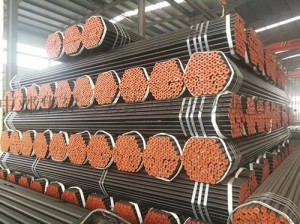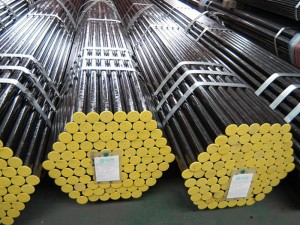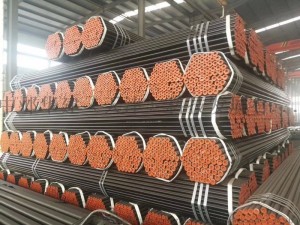-

A106grb seamless steel pipe manufacturer’s stock
Steel pipe has hollow section and its length is much larger than the diameter or circumference of steel. According to the section shape, it is divided into circular, square, rectangular and special-shaped steel pipes; According to the material, it is divided into carbon structural steel pipe, low alloy structural steel pipe, alloy steel pipe and composite steel pipe.
-

A106gr.B seamless steel pipe manufacturer direct sales
ASTM A106 seamless steel pipe belongs to American standard steel pipe, including a106-a and a106-b. The former is equivalent to the domestic 10# material, and the latter is equivalent to the domestic 20# material.
-

High pressure steel pipe manufacturer’s warranty
Genuine high-pressure steel pipe of large factory is of high quality and low price
High pressure steel pipe is a high-quality carbon steel, alloy structural steel and stainless steel seamless steel pipe used to manufacture high-pressure vessels and pipes.
-

Warranty of genuine boiler tube manufacturer
A large number of genuine high-pressure boiler tubes are in stock.
High pressure seamless steel pipe and high pressure boiler pipe are a kind of boiler pipe, belonging to the category of seamless steel pipe. The manufacturing method is the same as that of seamless pipe, but there are strict requirements for the steel grade used in the manufacture of steel pipe.
-

High pressure resistant boiler tube manufacturer genuine spot
Executive standard for medium and low pressure boiler tubes: GB3087-1999 seamless steel tubes for low and medium pressure boilers.
-

A333GR.6 A106C ST52 A213 T22 ST35 seamless steel pipe
Seamless steel pipe for low temperature pipeline
Spot specifications: 8-1240×1-200mm<1/8”—48”×SCH5S—SCH160, STD, XS, XXS>
Product material: 10MnDG, 09DG, 09Mn2VDG, 06Ni3MoDG,
ASTM A333-Grade1, Grade3, Grade4, Grade6, Grade7, Grade8, Grade9,
Grade10, Grade11
Product application: suitable for -45℃~-195℃ low-temperature pressure vessel pipes and seamless steel pipes for low-temperature heat exchanger pipes
Production process: cold drawn and hot rolled
Weight calculation formula: (outer diameter-wall thickness)*wall thickness*0.02466/1000=m/ton
Microstructure editing voice
The quenching temperature of low temperature steel pipe is A3+(30~50)℃. In actual operation, the upper limit is generally taken. A higher quenching temperature can speed up the heating speed of low-temperature steel pipes, reduce surface oxidation, and improve work efficiency. In order to homogenize the austenite of the workpiece, sufficient holding time is required. If the actual amount of furnace installed is large, the holding time needs to be extended appropriately. Otherwise, there may be insufficient hardness due to uneven heating. However, if the holding time is too long, coarse grains and serious oxidative decarburization will also occur, which will affect the quenching quality. We believe that if the installed furnace volume is greater than the provisions of the process documents, the heating and holding time needs to be extended by 1/5.
Because of the low hardenability of low-temperature steel pipes, a 10% saline solution with a high cooling rate should be used. After the workpiece enters the water, it should be quenched, but not cold. If the 45# precision steel pipe is cooled in salt water, it may crack the workpiece. This is because when the workpiece is cooled to about 180°C, the austenite rapidly transforms into horses. It is caused by the excessive structural stress caused by the body. Therefore, when the quenched low-temperature steel pipe is rapidly cooled to this temperature region, a slow cooling method should be adopted. Since the temperature of the outlet water is difficult to control, it must be operated by experience. When the shaking of the workpiece in the water stops, the outlet can be cooled by air (oil cooling is better). In addition, the workpiece should be moved but not static when entering water, and should be moved regularly according to the geometric shape of the workpiece. The static cooling medium and the static workpiece result in uneven hardness, uneven stress and large deformation or even cracking of the workpiece.
The hardness of the quenched and tempered part of low temperature steel pipe after quenching should reach HRC56~59. The possibility of large cross-section is lower, but it cannot be lower than HRC48. Otherwise, it means that the workpiece has not been completely quenched, and sorbite or even ferrite may appear in the structure. Organization, this kind of organization is still retained in the matrix through tempering, failing to achieve the purpose of quenching and tempering.
The high temperature tempering of low temperature steel pipe after quenching, the heating temperature is usually 560~600℃, and the hardness requirement is HRC22~34. Because the purpose of quenching and tempering is to obtain comprehensive mechanical properties, the hardness range is relatively wide. However, if the drawings have hardness requirements, the tempering temperature must be adjusted according to the drawings to ensure the hardness. For example, some shaft-type low-temperature steel pipes require high strength and hardness requirements; and some gears and shaft parts with keyways need to be milled and inserted after quenching and tempering, so the hardness requirements are lower. Regarding the tempering and holding time, it depends on the hardness requirements and the size of the workpiece. We believe that the hardness after tempering depends on the tempering temperature, and has little to do with the tempering time, but it must be back through. Generally, the tempering and holding time of the workpiece is always More than one hour.

- Call Support 0086-18365819992
- Email Support sales@weichuanmetal.com





